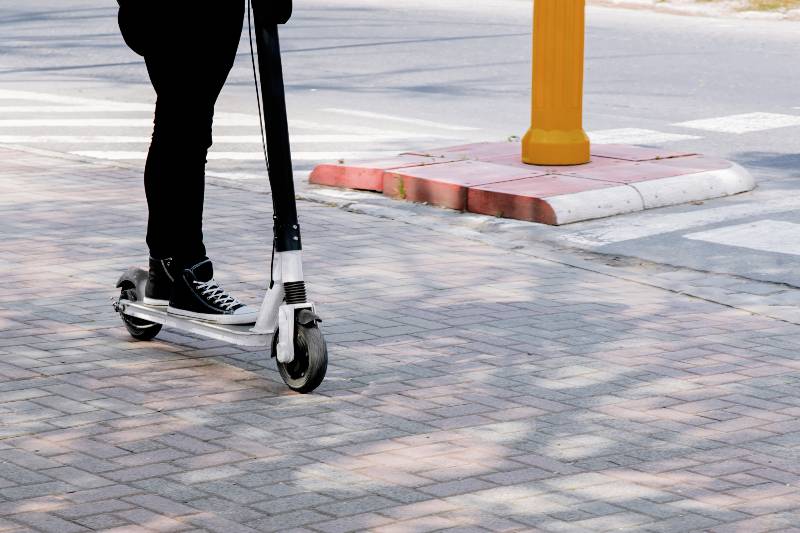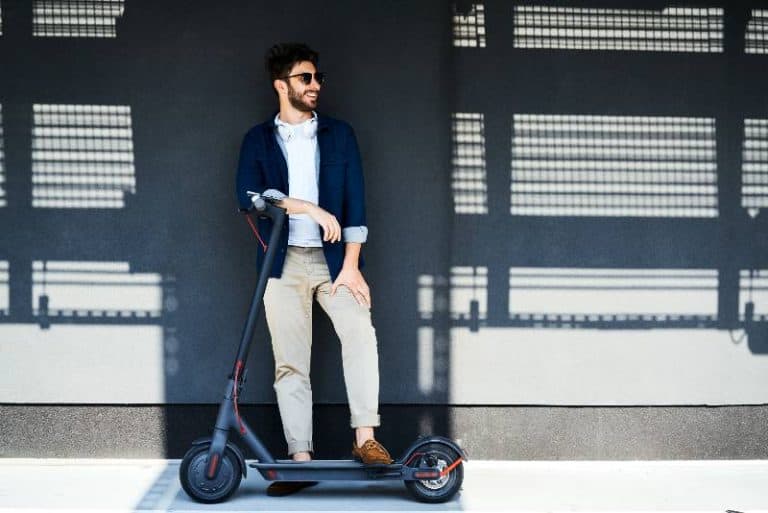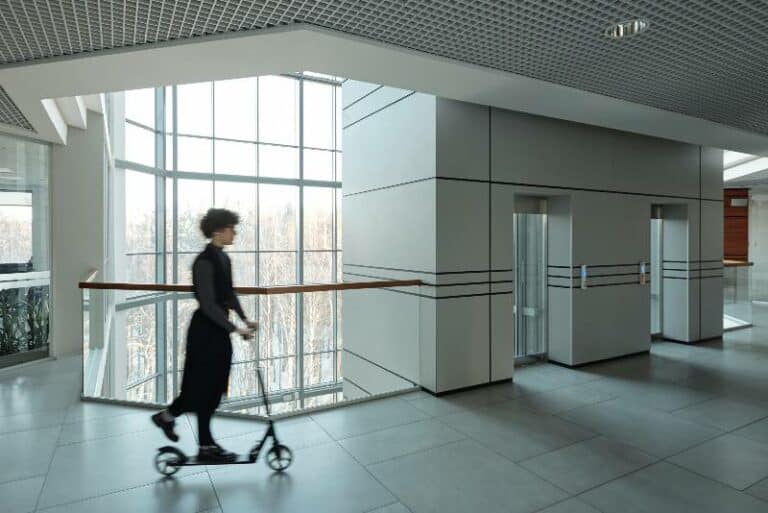How E-scooters are Easing City Traffic Woes
Imagine ditching the traffic jams and steadily chugging your way to work – all while enjoying a breeze of fresh morning air. That’s exactly what e-scooters are making possible. These electric powered two-wheeled vehicles, which have become increasingly popular in cities around the world, offer convenient micro mobility solutions that can ease our journey from one place to another without significantly contributing to urban traffic congestions.
In this blog post, we’ll explore how they’re transforming urban travel by delving into their history, looking at their benefits and potential concerns regarding safety and regulations. So get ready to speed up your commute while learning more about the nifty transportation option known as e-scooters!
During the study, commuting times were significantly reduced, resulting in a total saving of 4,000 hours for users. Additionally, e-scooter trips replaced over 30,000 miles of motorized transport journeys, making a positive impact on reducing pollution and congestion in the city.
Key Takeaways
- E-scooters offer a sustainable and efficient solution to the growing problem of urban traffic congestion, providing an alternative mode of transport for short-distance travel.
- While e-scooters present numerous benefits, they also come with challenges such as safety concerns, infrastructure needs, and regulatory hurdles that cities must address.
- The future of urban transportation could see a greater integration of e-scooters with other modes of transport, further alleviating traffic woes and promoting green travel.

History and Rise of E-scooters
Electric scooters, or e-scooters, have become an inseparable part of the urban landscape globally. With their ease of access, affordability, and eco-friendly nature, e-scooters have emerged as a popular choice for short-distance travel in cities. This article takes a look at the origins of e-scooters, their evolution, and their increasing adoption across the world.
History of E-Scooters
The concept of electric scooters isn’t recent. Ever since the invention of electric motors, engineers have experimented with their use in various forms of personal mobility. However, the development and commercial success of e-scooters as we know them today can be traced back to the late 1990s and early 2000s.
During this period, a few companies began selling electric scooters designed primarily for children and teenagers. These scooters, while not powerful, offered a fun alternative to traditional skateboards or bicycles.
The credit for converting e-scooters into a viable adult-sized transportation goes to Segway, which launched its self-balancing personal transporter in 2001. Though not technically an e-scooter, the Segway showcased what electric personal transport could achieve.
Evolution of E-Scooters
Despite the early success of companies like Segway, e-scooters remained a niche product for a few years. Issues such as battery life, speed capacity, and build quality needed to be addressed to make e-scooters a practical transportation device.
The real game-changer was the advent of lithium-ion battery technology in the late 2000s. The immense energy storage capability in a compact size offered by these batteries meant that e-scooters could be made lighter, travel farther, and run faster.
Additionally, advancements in motor technology, electric controls, and regenerative braking systems improved the performance and efficiency of e-scooters. Today’s e-scooters not only encompass these technological advancements but also incorporate distinct features such as digital connectivity, GPS tracking, smart locking systems, and user-friendly apps.
Popularity and Adoption in Various Cities
The popularity of e-scooters truly exploded with the rise of rental platforms like Bird and Lime that launched dockless e-scooter sharing services. Bird introduced its service in Santa Monica, California, in 2017 and set the stage for the global e-scooter revolution. By placing e-scooters onto the sidewalks of cities, they bypassed the need for individuals to purchase their own scooters, making them accessible to the general public at a relatively low cost.
This model’s success saw rapid adoption and expansion worldwide. From Paris to Mexico City to Melbourne, e-scooter rental services have proliferated, reaching peak numbers of usage in just a few years. Cities have recognized the benefits these services offer in reducing congestion, lowering carbon emissions, providing first and last-mile transportation solutions, and supplementing public transit.
While certain challenges need addressing, including public safety concerns, unclear legislation concerning their use, and e-waste management, the rise of e-scooters is seemingly unstoppable. Looking to the future, e-scooters will likely continue to evolve, becoming an increasingly integrated part of the urban transport landscape worldwide.
Benefits of E-scooters in Reducing Traffic Congestion
Traffic congestion is a significant issue in most urban centers worldwide, contributing to increased commute times, air pollution, stress levels and, by extension, diminished quality of life. As a response to this growing problem, many cities are increasingly looking to electric scooters (e-scooters) as a feasible solution. Here’s why e-scooters have been so positively received:
Reduction in Number of Cars
A key advantage of encouraging the use of e-scooters is the potential reduction in the number of cars on the road, particularly for short journeys. It is estimated that a significant percentage of car trips in urban areas are for distances less than 5 miles – an ideal range for e-scooters.
This translates to fewer vehicles competing for road space during peak hours, leading to less congestion. In fact, converting even a small percentage of car trips to e-scooter rides could markedly improve traffic conditions, lower commute times, and make urban environments more liveable.
Efficiency for Short-Distance Travel
E-scooters are particularly suited for short-distance travel in urban settings. Thanks to their small size and agility, e-scooters can navigate through traffic more efficiently than most other vehicles, facilitating faster and more reliable journeys.
Also, their compact size means they occupy less road space, freeing up lanes and helping to reduce congestion. In addition to using them for complete journeys, commuters can use e-scooters as a “first mile/last mile” solution, bridging gaps between homes, workplaces, and transit stops, therefore giving public transportation a convenience boost.
Environmentally Friendly Alternative
E-scooters run on electricity, making them an environmentally friendly alternative to car travel, which predominantly relies on fossil fuels. Cars contribute significantly to air pollution and CO2 emissions, leading to negative impacts on health and climate change.
By contrast, e-scooters produce zero tailpipe emissions. A shift from cars to e-scooters—especially for short journeys—can dramatically reduce cities’ carbon footprints. Although the production and disposal of e-scooters do have an environmental impact, this is considerably lesser than the lifetime emissions resulting from car production and usage.
Increasing e-scooter usage can offer a triple-win situation for urban environments: less congestion, more efficient commutes, and a decrease in carbon emissions. Alongside other forms of micro-mobility and improved public transport, e-scooters are set to play a significant role in creating more sustainable and less congested urban transport networks in the future. As this transition happens, ensuring the responsible use of e-scooters based on robust regulations will be key to unlocking their potential benefits.
E-Scooters in Urban Traffic: Challenges and Concerns
While e-scooters provide numerous benefits including reduction in traffic congestion and environmentally friendly short-distance travel, their rise has brought forth a range of challenges and concerns. These include safety issues, infrastructure and parking concerns, along with regulatory and legal challenges.
Safety Issues and Accidents
Perhaps the most immediate concern regarding e-scooters is the safety of the riders and others using the city streets. E-scooter accidents have been on the rise with the growing popularity of these vehicles, leading to injuries, property damage, and even fatalities. Accidents may be attributed to factors like poor road conditions, rider inexperience, or lack of safety gear such as helmets. Collisions with pedestrians or vehicles can occur if riders use sidewalks, bike lanes, or roads improperly.
Moreover, e-scooters often have a higher center of gravity than bicycles or motorcycles which can lead to stability issues. Also, their smaller wheels are not well-suited to handle potholes, curbs, or other obstacles that larger vehicles can handle easily.
Infrastructure and Parking Challenges
One of the biggest infrastructure challenges is the lack of dedicated lanes for e-scooters in many cities, forcing riders to share lanes with bikes or cars, and increasing the risk of accidents. An effort needs to be made to create safe and accessible infrastructure for e-scooter riders, such as dedicated lanes and ample parking spots.
Improperly parked e-scooters can clutter sidewalks and create situations that hinder pedestrians and those with disabilities. In some cities, dockless e-scooters have been dumped in piles, thrown into rivers, or left strewn across sidewalks, prompting complaints about visual pollution and creating a nuisance for pedestrians.
Regulatory and Legal Challenges
E-scooters exist in a regulatory gray area in many jurisdictions. There’s often confusion about where they can be ridden (sidewalks, bike lanes, or roads), what safety equipment is needed, and what the age limit for riders should be.
Several jurisdictions struggle with how to enforce rules on e-scooter speed, parking, and rider behavior. Enforcement becomes particularly challenging when riders are not easily identifiable, unlike car drivers who have license plates.
To solve these issues, city and state governments worldwide are drafting and refining laws around e-scooter use. However, achieving the right balance that ensures safety, reduces nuisance, but still promotes this eco-friendly mode of transportation is proving to be a complex task.
E-Scooters in Urban Traffic: Case Studies, Impact and Lessons Learned
As cities worldwide grapple with traffic congestion and environmental concerns, e-scooters have emerged as a potential solution. Several cities have embraced this new mode of transport with notable impacts on urban mobility patterns.
City Case Studies
Santa Monica, California
Santa Monica, where Bird first launched its e-scooter service in 2017, has witnessed a particularly significant impact. After a contentious start, involving issues of licenses and permits, the city adopted a pilot program to understand and regulate the e-scooter sharing service.
According to city data, in the initial year of regulated operations, shared scooters and bikes replaced almost 3 million miles of car travel, and 49% of riders reported using them to commute or run errands.
Paris, France
Paris is another city where e-scooters have made their mark. With over 20,000 scooters from various providers, Paris has become the European capital of e-scooters. City data reveals that in 2020, residents of Paris made more than 15 million trips on shared e-scooters.
However, Paris has also faced significant challenges, particularly related to scooters cluttering sidewalks or being left in inconvenient locations. In response, the city imposed stricter rules on e-scooter operations, including limits on the number of providers, enforcement of parking norms, and lower speed limits in certain areas.
Lessons Learned and Best Practices
Based on the experiences of these cities, there are several key lessons and best practices that other cities can apply:
- Establish regulations: Cities should establish clear guidelines and regulations concerning e-scooter operations, including rules for parking, speed limits, and the number of e-scooter vendors.
- Invest in Infrastructure: Dedicated lanes for e-scooters and designated parking spots are crucial to ensure that e-scooters can coexist safely with other forms of transport and don’t obstruct public spaces.
- Collaborate with Providers: Cities should work closely with e-scooter providers to solve any emerging issues. Data sharing agreements can also be beneficial for urban planning and to ensure service providers comply with regulations.
- Educate the Public: Cities should invest in public education campaigns about e-scooter safety and etiquette. This could include events, signage, and information in the app to educate riders before they start their ride.
Future of E-scooters in Urban Areas
Electric scooters or e-scooters have rapidly come to represent a vital aspect of urban mobility. They offer an eco-friendly method of transportation and potential solution to city congestion problems. As we look to the future, the influence of e-scooters on urban mobility can be expected to grow, driven by technological advancements, better integration with other transportation systems, and their potential for further reducing traffic congestion.
Technological Advancements in E-Scooters
Future trends in e-scooter technology present exciting possibilities for enhancing user experience, safety and operational efficiency.
Improved Battery Life and Speed: E-scooters may benefit from advancements in battery technology to allow for longer use and improved speed control. Faster charging batteries could improve scooter uptime, thus enhancing their appeal for commuting purposes.
Enhanced Safety Features: Future e-scooters may come with stronger breaking systems, better lights and signals, wider tires for improved stability, and intelligent features such as collision detection systems, to ensure rider safety.
Smart and Connected Scooters: Future iterations of e-scooters will likely be more connected, offering a range of smart features. This could include integration with mobile applications to give real-time information to users about the status of the scooter, GPS to help locate dockless scooters and to better manage scooter fleets, and far more advanced tracking of usage data to improve services.
Integration with Other Transportation Systems
For e-scooters to become a more viable and widespread mode of transportation, they need to be seamlessly integrated with other transit systems. This can be done in the following ways:
Transit Hubs: E-scooters can be strategically placed at transit hubs like bus stations, train stations, and subway exits to provide a means of accomplishing the last-mile journey.
Integration within Transit Apps: E-scooter availability and booking can be integrated into existing transit apps to allow easy switching between various modes of transportation.
Shared Payment Systems: By integrating payment systems, users could pay for an entire journey, including e-scooter rental, bus fare, and train tickets, in one single, effortless transaction.
Reducing Traffic Congestion
E-scooters have the potential to play a major role in reducing traffic congestion. Occupying less space than cars and even bikes, they facilitate smoother traffic flow. They are ideally suited for short trips and could help reduce over-reliance on cars for short distances, thus helping to alleviate urban congestion.
Moreover, as city infrastructure adapts to accommodate e-scooters, dedicated lanes will be created, further separating scooter traffic from traditional vehicle traffic, thus contributing to more efficient overall traffic movement.

E-scooters in Urban Traffic FAQs
How have e-scooters contributed to reducing traffic congestion?
E-scooters have the potential to greatly reduce traffic congestion by providing an alternative mode of transportation for short trips. Their compact size and ease of use make them a convenient option for urban areas, thus reducing reliance on cars for short distances.
Are e-scooters safe to use in busy urban areas?
E-scooters can be a safe mode of transportation if used responsibly. Cities should establish regulations and invest in infrastructure to ensure the safety of both riders and pedestrians. Additionally, education campaigns can help promote safe riding practices.
How do e-scooters compare to other forms of transportation in terms of efficiency?
E-scooters are a highly efficient mode of transportation, especially for short trips in urban areas. They require less space on the road and have lower emissions compared to cars, making them a more sustainable option. They can also help alleviate traffic congestion, thus improving overall efficiency in urban traffic.
What are the environmental benefits of using e-scooters?
E-scooters produce zero emissions and have a lower carbon footprint compared to other forms of motorized transportation. By reducing reliance on cars, e-scooters can also help improve air quality in cities.
How can cities ensure the responsible use of e-scooters?
Cities can establish regulations for e-scooter use, work closely with service providers to address any issues that may arise, and invest in public education campaigns to promote safe and responsible riding habits. Data sharing agreements can also help cities better manage and regulate e-scooter services.
How are cities regulating the use of e-scooters?
Cities are implementing various regulations to ensure the safe and responsible use of e-scooters. This includes speed limits, designated parking areas, and restrictions on where e-scooters can be used. Some cities also require helmets to be worn while riding an e-scooter.
Conclusion
Ultimately, e-scooters offer a sustainable and feasible alternative to traditional modes of transport, allowing for more convenient, healthier short distance trips. Cities will need to take measures that ensure a safe and responsible use of e-scooters while investing in the infrastructure necessary for its widespread adoption. By leveraging the potential of e-scooters to reduce congestion and promote accessibility, cities can pave the way towards greener urban transportation systems in the future.
Don’t miss out on all the exciting developments to come – sign up for Electrik Living News on our website today and be one of the first to get updates concerning e-scooter trends and other solutions for sustainable city living!






